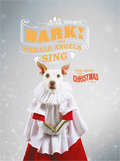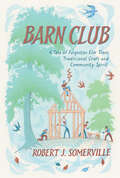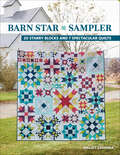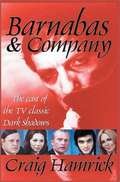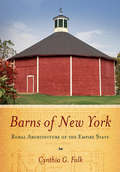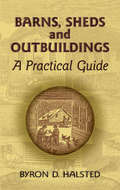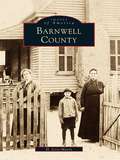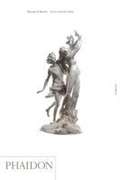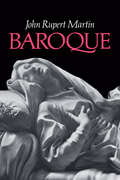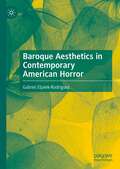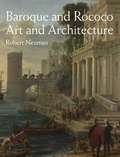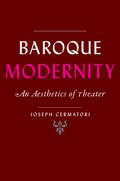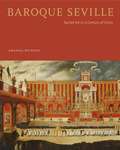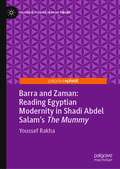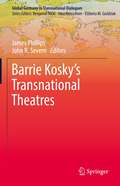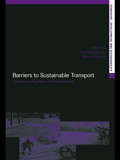- Table View
- List View
Bark! The Herald Angels Sing: The Dogs of Christmas
by Peter ThorpeMagical portraits of a photographer's dog, in elaborate Christmas compositions Bark! The Herald Angels Sing will bring a smile to even the most devoted Scrooge. Decked out in the finest of holiday garb, strutting against backgrounds that evoke locales as varied as Charles Dickens' London and the ice floes of Antarctica, an adorable dog strikes a pose. Another Christmas card in the bag. But the scenes weren't always so ornate. Photographer Peter Thorpe's first dog holiday shoot went more like this: dog, pair of antlers, red Rudolph nose, done. That card went out to family and friends--and the rest, as they say, is history. From Rudolph in 1990 to Santa in 2015, Paddy and Raggles, donned in festive costumes, adorned cards every December without fail. Collected here, the photographs--and the outtakes--include Paddy as tree-topper and Raggles dressed as a sheep in a stable, Robin Red Breast, and, of course, Ebenezer Scrooge. In prose that accompanies each image, Thorpe describes his inspiration for a given card. He kept to photographic traditions of yesteryear, making his own sets and props--no digital retouching here. With sly humor and faux how-to directions, he suggests how readers might attempt to capture the same scenes with their pups. (Spoiler alert: Dog models must be able to balance on top of a Christmas tree and their owners will need woodworking skills to build giant mousetraps.) This book is sure to become a tradition of its very own.
Barn Club: A Tale of Forgotten Elm Trees, Traditional Craft and Community Spirit
by Robert Somerville"In today’s ego-techno-centred world, Robert Somerville’s… ‘Barn Club’ approach is a way forward that utilizes local traditions, local materials and local hands to create a built environment that is more harmonious with the natural world and of course more beautiful."—Jack A. Sobon, architect, timber framer, and author of Hand Hewn Natural history meets traditional hand craft in this celebration of the elm tree and community spirit. Perfect for fans of Norwegian Wood and The Hidden Life of Trees Barn Club calls on us to discover our landscapes more intimately and to explore the joys of making beautiful things by hand, together. When renowned craftsman Robert Somerville moved to Hertfordshire, in southern England, he discovered an unexpected landscape rich with wildlife and elm trees. Nestled within London’s commuter belt, this wooded farmland inspired Somerville, a lifelong woodworker, to revive the ancient tradition of hand-raising barns. Barn Club follows the building of Carley Barn, over the course of one year. Volunteers from all walks of life joined Barn Club, inspired to learn this ancient skill of building elm barns by hand, at its own quiet pace and in the company of others, while using timber from the local woods. The tale of the elm tree in its landscape is central to Barn Club. Its natural history, historic importance, and remarkable survival make for a fascinating story. This is a tale of forgotten trees, a local landscape, and an ancient craft. This book features 16 pages of color photographs, and black and white line drawings of techniques and traditional timber frame barns feature throughout.
Barn Club: A Tale of Forgotten Elm Trees, Traditional Craft and Community Spirit
by Robert Somerville&“In today&’s ego-techno-centred world, Robert Somerville&’s . . . Barn Club approach is a way forward that utilizes local traditions, local materials, and local hands to create a built environment that is more harmonious with the natural world and of course more beautiful.&”—Jack A. Sobon, architect, timber framer, and author of Hand Hewn&“Somerville knows more about wooden barn construction than almost anyone alive.&”—The TelegraphNatural history meets traditional hand craft in this celebration of the elm tree and community spirit.When renowned craftsman Robert Somerville moved to Hertfordshire in southern England, he discovered an unexpected landscape rich with wildlife and elm trees. Nestled within London&’s commuter belt, this wooded farmland inspired Somerville, a lifelong woodworker, to revive the ancient tradition of hand-raising barns.Barn Club follows the building of Carley Barn over the course of one year. Volunteers from all walks of life joined Barn Club, inspired to learn this ancient skill of building elm barns by hand, at its own quiet pace and in the company of others, while using timber from the local woods.The tale of the elm tree in its landscape is central to Barn Club. Its natural history, historic importance, and remarkable survival make for a fascinating story.This is a tale of forgotten trees, a local landscape, and an ancient craft.This book includes sixteen pages of color photographs, and black and white line drawings of techniques and traditional timber frame barns feature throughout.Perfect for fans of Norwegian Wood and The Hidden Life of Trees.
Barn Star Sampler: 20 Starry Blocks and 7 Spectacular Quilts
by Shelley CavannaSew starry quilt blocks Inspired by painted and wood quilt blocks that adorn barns, author Shelley Cavanna shares 20 blocks and seven quilt designs destined to pass the test of time. The Barn Star Sampler quilt, quite possibly the star of the show, incorporates 20 different block designs spanning 4" to 24" in a fresh and modern sampler-quilt layout. Combine patchwork blocks to create a table runner, a wall quilt, a lap quilt, and full-size bed quilt designs. With so many block sizes, star variations, and layouts, the sky's the limit! Sew fan-favorite star blocks like the Carpenter Star, Sawtooth Star, Christmas Star, Pinwheel Star, Peony Star, and more! Make charming projects for the home, including lap quilts, wall hangings, and even a table runner designed to use up leftover triangle trimmings. Find helpful tutorials for blocks frequently used in the book with guidance on the stitch-and-flip assembly method.
Barnabas & Company: The Cast of the TV Classic Dark Shadows
by Craig HamrickBarnabas and Company tells the tale of the (mostly) marvelous actors and actresses who came together in a tiny studio in Manhattan to make magic--both on screen and off. "Dark Shadows" innovatively broke all the daytime rules and blazed a trail other soaps are still following. Featuring sympathetic vampires and werewolves, decades before "Buffy the Vampire Killer" made slaying cool, the show captured the nation's attention. In the actors' own words, read about how it happened, and relive your own special memories of those "Dark Shadows" in the afternoon. Plus, a special trivia section includes information on the actors' other roles--on TV, stage and in movies.
Barns of Connecticut (Garnet)
by Markham StarrFeaturing more than 100 stunning full-color photographs along with helpful diagrams and historic photos, Barns of Connecticut captures both the iconic and the unique, including historic and noteworthy barns. The book discusses the importance of barns to Connecticut agriculture across our state and up to the present day. Markham Starr's Barns of Connecticut offers a lovely introduction to the architectural, functional, and agricultural roles these structures played in early Connecticut. Through text and color photographs, it tells a story of change and continuity. From the earliest colonial structures to the low steel buildings of modern dairy farms, barns have adapted to meet the needs of each generation; they've stored wheat, hay, and tobacco, and housed farm animals and dairy cows. These enduring structures display the optimism, ingenuity, hard work, and practicality of the people who tend land and livestock throughout the state.
Barns of New York: Rural Architecture of the Empire State
by Cynthia FalkBarns of New York explores and celebrates the agricultural and architectural diversity of the Empire State-from Long Island to Lake Erie, the Southern Tier to the North Country-providing a unique compendium of the vernacular architecture of rural New York. Through descriptions of the appearance and working of representative historic farm buildings, Barns of New York also serves as an authoritative reference for historic preservation efforts across the state.Cynthia G. Falk connects agricultural buildings-both extant examples and those long gone-with the products and processes they made and make possible. Great attention is paid not only to main barns but also to agricultural outbuildings such as chicken coops, smokehouses, and windmills. Falk further emphasizes the types of buildings used to support the cultivation of products specifically associated with the Empire State, including hops, apples, cheese, and maple syrup.Enhanced by more than two hundred contemporary and historic photographs and other images, this book provides historical, cultural, and economic context for understanding the rural landscape. In an appendix are lists of historic farm buildings open to the public at living history museums and historic sites. Through a greater awareness of the buildings found on farms throughout New York, readers will come away with an increased appreciation for the state's rich agricultural and architectural legacy.
Barns, Sheds and Outbuildings: A Practical Guide
by Byron D. HalstedAccompanied by more than 250 illustrations, Halsted's environmentally sensitive manual was written with the farmer in mind — and during a time when a laborer earned a mere dollar a day. His barn-building theories extend to dog- and bird-houses, and are based upon qualities we still hold dear: light and air, space, cost, and beauty, as well as permanence, convenience, and workability.This facsimile edition of the 1881 book of plans and instructions will engage the reader with its anecdotal style. Nearly 100 structures span the gamut of farm buildings: from monumental barns--four stories high and covering nearly an acre, to lowly hen coops and root cellars. The particulars of their construction, recounted in simple and practical terms, tell a timeless tale of life lived amid the changing seasons and the natural world.
Barnwell County
by H. Jerry MorrisBarnwell County, an area blessed with sweeping rural landscapes, has played an important role in South Carolina's distinguished history, from its roots in agriculture to its development of the government-owned Savannah River Plant. This visual history celebrates many of the county's small towns, such as Barnwell, Williston, and Blackville, and includesfascinating images of some of the smaller communities. In Barnwell County, you will experience an incredible visual tour of yesteryear, viewing Barnwell County through both photographs and postcards from the turn of the twentieth century to the 1960s. As you thumb through these pages, you will stroll along dusty downtown streets; visit the local train depots; read the time on the vertical sundial located next to the Barnwell Courthouse; explore the facilities of the German Prisoner of War Camp and see some of its inmates hard at work;investigate many of the old, wooden-frame churches scattered throughout the county; sit in on classes in one-room schoolhouses, including many of the African-American schools in the 1930s; watch trucks lumbering along dirt roads and balancing large homes from Dunbarton on their truckbeds; meet a few of Barnwell County's more prominent citizens, such as C.G. Fuller, Representative Sol Blatt, and Senator Edgar Brown; and enjoy a variety of everyday activities, such as hunting, scouting, attending family reunions, or riding in classic automobiles along county roads.
Baroque & Rococo
by Gauvin Alexander BaileyThis new title in the highly regarded Art & Ideas series presents a thorough introduction to the Baroque and Rococo styles. Encompassing architecture, interior design, furniture, ceramics, garden landscaping and theatrical spectaculars, as well as the masterpieces of this prolific period in the Fine Arts, these styles were global and had enormous impact on the history of art. Gauvin Bailey clarifies the essence of the styles and examines their complexities and contradictions, and their applications against the backdrop of seventeenth- and eighteenth-century Europe, Latin America and Asia. With 250 illustrations, well-known sculptures by Bernini, paintings by Caravaggio and Rembrandt, and some of the most famous buildings in the world are set in their creative milieu with succinct analysis and broad clarity. Lesser known examples from across the world demonstrate how the aesthetic trends of the styles were concurrent throughout continents, and enlightens and refreshes the implications of the terms.
Baroque (Icon Editions Ser.)
by John Rupert MartinThis is a nonchronological introduction to Baroque, one of the great periods of European art. John Martin's descriptions of the essential characteristics of the Baroque help one to gain an understanding of the style. His illustrations are informative and he has clearly looked with a fresh eye at the works of art themselves. In addition to the more than 200 illustrations, the volume contains an appendix of translated documents.
Baroque Aesthetics in Contemporary American Horror
by Gabriel Eljaiek-RodríguezThis book traces a trend that has emerged in recent years within the modern panorama of American horror film and television, the concurrent—and often overwhelming—use of multiple stock characters, themes and tropes taken from classics of the genre. American Horror Story, Insidious and The Conjuring are examples of a filmic tendency to address a series of topics and themes so vast that at first glance each taken separately would seem to suffice for individual films or shows. This book explores this trend in its visible connections with American Horror, but also with cultural and artistic movements from outside the US, namely Baroque art and architecture, Asian Horror, and European Horror. It analyzes how these hybrid products are constructed and discusses the socio-political issues that they raise. The repeated and excessive barrage of images, tropes and scenarios from distinct subgenres of iconic horror films come together to make up an aesthetic that is referred to in this book as Baroque Horror. In many ways similar to the reactions provoked by the artistic movement of the same name that flourished in the XVII century, these productions induce shock, awe, fear, and surprise. Eljaiek-Rodríguez details how American directors and filmmakers construct these narratives using different and sometimes disparate elements that come together to function as a whole, terrifying the audience through their frenetic accumulation of images, tropes and plot twists. The book also addresses some of the effects that these complex films and series have produced both in the panorama of contemporary horror, as well as in how we understand politics in a divisive world that pushes for ideological homogenizations.
Baroque And Rococo Art And Architecture
by Robert NeumanBaroque and Rococo Art and Architecture is the first in-depth history of one of the great periods of Western art, spanning the years 1585 to 1785. The text treats the major media—painting, sculpture, drawings, prints, and architecture—as well as gardens, furniture, tapestries, costume, jewelry, and ceramics, all in terms of their original function and patronage and with emphasis on the social, political and cultural context. Organized by country and medium, the book contains biographies of the leading creative figures of the time, from Caravaggio and Rembrandt to Watteau and Hogarth. Significantly, Professor Neuman offers the fullest account to date of women artists and the representation of women and families in art. Additionally, drawing from recent scholarship, the text explores such fields as Spanish polychrome sculpture and Viceregal American painting. <p><p> Baroque and Rococo Art and Architecture reviews traditional and recent strategies for interpreting artworks. It also traces the dissemination of visual ideas through prints and drawings—the forerunners of today's art reproductions and digital media. In special sections the text raises questions regarding the nature of perception and how artists transfer optical data to the canvas. Artists' techniques, from painting and printmaking to sculpting in marble and casting in bronze, are explained. Analysis of the institutions of art, such as the royal academies, apprenticeship systems, and artists' exhibition rooms, complements an examination of collecting at all levels of society. The book is exceptional in considering issues related to authenticity and the relative value of artworks based on attribution. <p> The illustrations comprise a visual resource of unprecedented quality, with some 450 images reproduced in full color and in a large format that ensures high detail and emphasizes recent conservation efforts. Finally, an extensive glossary introduces seventeenth- and eighteenth-century art terms.
Baroque Antiquity
by Tschudi Victor PlahteWhy were seventeenth-century antiquarians so spectacularly wrong? Even if they knew what ancient monuments looked like, they deliberately distorted the representation of them in print. Deciphering the printed reconstructions of Giacomo Lauro and Athanasius Kircher, this pioneering study uncovers an antiquity born with print culture itself and from the need to accommodate competitive publishers, ambitious patrons and powerful popes. By analysing the elements of fantasy in Lauro and Kircher's archaeological visions, new levels of meaning appear. Instead of being testimonies of failed archaeology, they emerge as complex architectural messages responding to moral, political, and religious issues of the day. This book combines several histories - print, archaeology, and architecture - in the attempt to identify early modern strategies of recovering lost Rome. Many books have been written on antiquity in the Renaissance, but this book defines an antiquity that is particularly Baroque.
Baroque Modernity: An Aesthetics of Theater (Hopkins Studies in Modernism)
by Joseph CermatoriA groundbreaking study on the vital role of baroque theater in shaping modernist philosophy, literature, and performance.Winner, Helen Tartar First Book Subvention AwardBaroque style—with its emphasis on ostentation, adornment, and spectacle—might seem incompatible with the dominant forms of art since the Industrial Revolution, but between 1875 and 1935, European and American modernists connected to the theater became fascinated with it. In Baroque Modernity, Joseph Cermatori argues that the memory of seventeenth-century baroque stages helped produce new forms of theater, space, and experience around the turn of the twentieth century. In response, modern theater helped give rise to the development of the baroque as a modern philosophical idea. The book focuses on avant-gardists whose writing takes place between theory and performance: philosophical theater-makers and theatrical philosophers including Friedrich Nietzsche, Stéphane Mallarmé, Walter Benjamin, and Gertrude Stein. Moving between page and stage, this study tracks the remnants of seventeenth-century theater through modernist aesthetics across an array of otherwise disparate materials, including modern opera, Bertolt Brecht's Epic Theater, poetic tragedies, and miracle plays. By reexamining the twentieth century's engagements with Gianlorenzo Bernini, William Shakespeare, Claudio Monteverdi, Calderón de la Barca, and other seventeenth-century predecessors, the book delineates an enduring tradition of baroque performance. Along the way, Cermatori expands our familiar narratives of "the modern" and traces a history of theatricality that reverberates into the twenty-first century. Baroque Modernity will appeal to readers in a wide array of disciplines, including comparative literature, theater and performance, art and music history, intellectual history, and aesthetic theory.
Baroque Seville: Sacred Art in a Century of Crisis
by Amanda WunderBaroque art flourished in seventeenth-century Seville during a tumultuous period of economic decline, social conflict, and natural disasters. This volume explores the patronage that fueled this frenzy of religious artistic and architectural activity and the lasting effects it had on the city and its citizens.Amanda Wunder investigates the great public projects of sacred artwork that were originally conceived as medios divinos—divine solutions to the problems that plagued Seville. These commissions included new polychromed wooden sculptures and richly embroidered clothing for venerable old images, gilded altarpieces and monumental paintings for church interiors, elaborate ephemeral decorations and festival books by which to remember them, and the gut renovation or rebuilding of major churches that had stood for hundreds of years. Meant to revive the city spiritually, these works also had a profound real-world impact. Participation in the production of sacred artworks elevated the social standing of the artists who made them and the devout benefactors who commissioned them, and encouraged laypeople to rally around pious causes. Using a diverse range of textual and visual sources, Wunder provides a compelling look at the complex visual world of seventeenth-century Seville and the artistic collaborations that involved all levels of society in the attempt at its revitalization.Vibrantly detailed and thoroughly researched, Baroque Seville is a fascinating account of Seville’s hard-won transformation into one of the foremost centers of Baroque art in Spain during a period of crisis.
Baroque Seville: Sacred Art in a Century of Crisis
by Amanda WunderBaroque art flourished in seventeenth-century Seville during a tumultuous period of economic decline, social conflict, and natural disasters. This volume explores the patronage that fueled this frenzy of religious artistic and architectural activity and the lasting effects it had on the city and its citizens.Amanda Wunder investigates the great public projects of sacred artwork that were originally conceived as medios divinos—divine solutions to the problems that plagued Seville. These commissions included new polychromed wooden sculptures and richly embroidered clothing for venerable old images, gilded altarpieces and monumental paintings for church interiors, elaborate ephemeral decorations and festival books by which to remember them, and the gut renovation or rebuilding of major churches that had stood for hundreds of years. Meant to revive the city spiritually, these works also had a profound real-world impact. Participation in the production of sacred artworks elevated the social standing of the artists who made them and the devout benefactors who commissioned them, and encouraged laypeople to rally around pious causes. Using a diverse range of textual and visual sources, Wunder provides a compelling look at the complex visual world of seventeenth-century Seville and the artistic collaborations that involved all levels of society in the attempt at its revitalization.Vibrantly detailed and thoroughly researched, Baroque Seville is a fascinating account of Seville’s hard-won transformation into one of the foremost centers of Baroque art in Spain during a period of crisis.
Baroque Visual Rhetoric
by Vernon Hyde MinorIntricate, expressive, given to grandeur and even excess, Baroque art as a style is inseparable from the meanings it seeks to convey. Vernon Hyde Minor's Baroque Visual Rhetoric probes this combination of style and message and - equally importantly - the methodological basis on which the critical art historian comes to establish that meaning.Drawing on a breathtaking range of critical literature, from the German founders of art history as an academic discipline to Heidegger, Derrida, and de Man, Minor considers the issue through a series of Baroque masterpieces: Bernini's Baldacchino in St. Peter's Basilica, the statues in the church of San Giovanni in Laterano, Borromini's church of Sant'Ivo alla Sapienza, Baciccio's frescoes in the church of Il Gesù, the paintings of Philippe de Champaigne, and the Corsini Chapel in San Giovanni in Laterano.
Barra and Zaman: Reading Egyptian Modernity in Shadi Abdel Salam’s The Mummy (Palgrave Studies in Arab Cinema)
by Youssef RakhaBrilliantly introduced by Nezar Andary, this book is a work of creative nonfiction that approaches writing on film in a fresh and provocative way. It draws on academic, literary, and personal material to start a dialogue with the Egyptian filmmaker Shadi Abdel Salam’s The Mummy (1969), tracing the many meanings of Egypt’s postcolonial modernity and touching on Arab, Muslim, and ancient Egyptian identities through watching the film.
Barred for Life: How Black Flag's Iconic Logo Became Punk Rock's Secret Handshake
by Stewart Dean EbersoleCataloging the legacy of the American punk rock pioneers Black Flag, this photo documentary uses stark, contrasting portraits to share the stories of the die-hard fans who wear the iconic four-barred logo tattooed on their skin. From doctors to homeless punks, stories range from the intensely personal to the absurd as each larger-than-life soul mugs for the camera. Adding to the idea that mixed messages can come from one unifying design, each image is highlighted with a personal quotation, a name and bio, and a Black Flag favorites list. Captured during an extensive tour through the United States, Canada, and Western Europe, this collection serves as a visual testimony to the hyper-distilled mythology that the band is more prevalent now than when it was in service, and serves as a soundtrack for those living as self-imposed cultural outsiders. Interviews with former members of the band, tattoo artists, photographers, and other relevant luminaries round out this ethnography and serve to spotlight Black Flag's vicious live performances, forward-thinking work ethic, and indisputable reputation for acting as both champions and destroyers of the punk rock culture that they helped create.
Barrie Kosky on the Contemporary Australian Stage: Affect, Post-Tragedy, Emergency (Routledge Advances in Theatre & Performance Studies)
by Charlotte FarrellThis is the first book-length study of Australian theatre productions by internationally-renowned director, Barrie Kosky. Now a prolific opera director in Europe, Barrie Kosky on the Contemporary Australian Stage accounts for the formative years of Kosky's career in Australia. This book provides in-depth engagements with select productions including The Dybbuk which Kosky directed with Gilgul theatre company in 1991, as well as King Lear (1998), The Lost Echo (2006), and Women of Troy (2008). Using affect theory as a prism through which these works are analysed, the book accounts for the director's particular engagement with – and radical departure from – classical tragedy in contemporary performance: what the book defines as Kosky's 'post-tragedies'. Theatre studies scholars and students, particularly those with interests in affect, contemporary performance, 'director's theatre', and tragedy, will benefit from Barrie Kosky on the Contemporary Australian Stage’s vivid engagement with Kosky's work: a director who has become a singular figure in opera and theatre of international critical acclaim.
Barrie Kosky’s Transnational Theatres (Global Germany in Transnational Dialogues)
by James Phillips John R. SevernThis book, the first of its kind, surveys the career of the renowned Australian-German theatre and opera director Barrie Kosky. Its nine chapters provide multidisciplinary analyses of Barrie Kosky’s working practices and stage productions, from the beginning of his career in Melbourne to his current roles as Head of the Komische Oper Berlin and as a guest director in international demand. Specialists in theatre studies, opera studies, musical theatre studies, aesthetics, and arts administration offer in-depth accounts of Kosky’s unusually wide-ranging engagements with the performing arts – as a director of spoken theatre, operas, musicals, operettas, as an adaptor, a performer, a writer, and an arts manager. Further, this book includes contributions from theatre practitioners with first-hand experience of collaborating with Kosky in the 1990s, who draw on interviews with members of Gilgul, Australia’s first Jewish theatre company, to document this formative period in Kosky’s career. The book investigates the ways in which Kosky has created transnational theatres, through introducing European themes and theatre techniques to his Australian work or through bringing fresh voices to the national dialogue in Germany’s theatre landscape. An appendix contains a timeline and guide to Kosky’s productions to date.
Barrier-Free Design
by James Holmes-SeidleThis book for architects, interior designers, building managers, students, conference organisers looks at first principles to provide the user with the 'tools' to make their own decisions rather than a 'cookbook' approach. It is intended that designs and product information can be taken straight from the manual and inserted into ongoing projects. For the first time the book considers the needs of people with visual, hearing and mental disabilities, who make up the majority of disabled people in the population, alongside those of people with physical mobility disabilities. Practical low cost solutions to retro-fitting existing buildings are discussed, as well as the methods used to assess the suitability of an existing building, and assembling a project to improve access for disabled people. Specific products and designs are illustrated and discussed - with full working technical drawings, and full specification details. These will reduce considerably the research time needed to produce a cost-effective solution that will improve access for disabled people. A perspective of the standards and legislation dealing with access issues in the UK is compared with those in other countries, and the standards mentioned are compared with the realities of practical implementation carried out in 4 years of design in this area.
Barrier-Free Theatre
by Sally BaileyWays to use drama as a tool to teach traditional classroom subjects, such as science, social studies, and language arts, are highlighted, as well as using it for instruction in social interaction and other vital life skills.
Barriers to Sustainable Transport: Institutions, Regulation and Sustainability (Transport, Development and Sustainability Series)
by Roger R. Stough Piet RietveldThe complexity of transportation systems and their negative social and environmental effects are today at the centre of attention. This book focuses on the impact of institutions and regulatory systems on transport systems and travel behaviour. While institutions appear to play an important role in the economic success of many countries, this book considers the extent to which they also support sustainable development.
